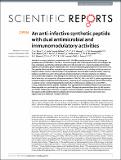| dc.contributor.author | Silva, O. N. | |
| dc.contributor.author | Haney, E. F. | |
| dc.contributor.author | Fensterseifer, I. C. M. | |
| dc.contributor.author | Ribeiro, S. M. | |
| dc.contributor.author | Porto, W. F. | |
| dc.contributor.author | Faria-Junior, C. | |
| dc.contributor.author | Rezende, T. M. B. | |
| dc.contributor.author | Moreno, S. E. | |
| dc.contributor.author | Hancock, R. E. W. | |
| dc.contributor.author | Franco, O. L. | |
| dc.contributor.author | de la Fuente Nunez, Cesar | |
| dc.contributor.author | Lu, Timothy K. | |
| dc.contributor.author | Brown, Paul | |
| dc.date.accessioned | 2016-11-02T19:55:29Z | |
| dc.date.available | 2016-11-02T19:55:29Z | |
| dc.date.issued | 2016-11 | |
| dc.date.submitted | 2016-06 | |
| dc.identifier.issn | 2045-2322 | |
| dc.identifier.uri | http://hdl.handle.net/1721.1/105167 | |
| dc.description.abstract | Antibiotic-resistant infections are predicted to kill 10 million people per year by 2050, costing the global economy $100 trillion. Therefore, there is an urgent need to develop alternative technologies. We have engineered a synthetic peptide called clavanin-MO, derived from a marine tunicate antimicrobial peptide, which exhibits potent antimicrobial and immunomodulatory properties both in vitro and in vivo. The peptide effectively killed a panel of representative bacterial strains, including multidrug-resistant hospital isolates. Antimicrobial activity of the peptide was demonstrated in animal models, reducing bacterial counts by six orders of magnitude, and contributing to infection clearance. In addition, clavanin-MO was capable of modulating innate immunity by stimulating leukocyte recruitment to the site of infection, and production of immune mediators GM-CSF, IFN-γ and MCP-1, while suppressing an excessive and potentially harmful inflammatory response by increasing synthesis of anti-inflammatory cytokines such as IL-10 and repressing the levels of pro-inflammatory cytokines IL-12 and TNF-α. Finally, treatment with the peptide protected mice against otherwise lethal infections caused by both Gram-negative and -positive drug-resistant strains. The peptide presented here directly kills bacteria and further helps resolve infections through its immune modulatory properties. Peptide anti-infective therapeutics with combined antimicrobial and immunomodulatory properties represent a new approach to treat antibiotic-resistant infections. | en_US |
| dc.description.sponsorship | Fundación Ramón Areces (Postdoctoral scholarship) | en_US |
| dc.description.sponsorship | Canada Research Chairs | en_US |
| dc.description.sponsorship | Brazil. National Council for Scientific and Technological Development (Postdoctoral scholarship) | en_US |
| dc.description.sponsorship | Fundação Cearense de Apoio ao Desenvolvimento Científico e Tecnológico, Ciência e Tecnologia do Estado de Mato Grosso do Sul (FUNDECT-Brazil [300583/2016-8]) | en_US |
| dc.description.sponsorship | National Institutes of Health (U.S.) (grant 1R01EB017755) | en_US |
| dc.description.sponsorship | National Institutes of Health (U.S.) (1R21AI12166901) | en_US |
| dc.description.sponsorship | United States. Defense Threat Reduction Agency (HDTRA1-14-1-0007) | en_US |
| dc.description.sponsorship | United States. Defense Threat Reduction Agency (HDTRA1- 15-1-0050) | en_US |
| dc.description.sponsorship | United States. Army Research Office. Institute for Soldier Nanotechnologies (contract number W911NF-13-D-0001) | en_US |
| dc.language.iso | en_US | |
| dc.publisher | Springer Nature | en_US |
| dc.relation.isversionof | http://dx.doi.org/10.1038/srep35465 | en_US |
| dc.rights | Creative Commons Attribution | en_US |
| dc.rights.uri | http://creativecommons.org/licenses/by/4.0/ | en_US |
| dc.source | Nature | en_US |
| dc.title | An anti-infective synthetic peptide with dual antimicrobial and immunomodulatory activities | en_US |
| dc.type | Article | en_US |
| dc.identifier.citation | Silva, O. N., C. de la Fuente-Núñez, E. F. Haney, I. C. M. Fensterseifer, S. M. Ribeiro, W. F. Porto, P. Brown, et al. “An Anti-Infective Synthetic Peptide with Dual Antimicrobial and Immunomodulatory Activities.” Scientific Reports 6 (November 2, 2016): 35465. | en_US |
| dc.contributor.department | MIT Synthetic Biology Center | en_US |
| dc.contributor.department | Massachusetts Institute of Technology. Department of Biological Engineering | en_US |
| dc.contributor.department | Massachusetts Institute of Technology. Department of Chemical Engineering | en_US |
| dc.contributor.department | Massachusetts Institute of Technology. Department of Electrical Engineering and Computer Science | en_US |
| dc.contributor.department | Massachusetts Institute of Technology. Research Laboratory of Electronics | en_US |
| dc.contributor.mitauthor | de la Fuente Nunez, Cesar | |
| dc.contributor.mitauthor | Lu, Timothy K. | |
| dc.contributor.mitauthor | Brown, Paul | |
| dc.relation.journal | Scientific Reports | en_US |
| dc.eprint.version | Final published version | en_US |
| dc.type.uri | http://purl.org/eprint/type/JournalArticle | en_US |
| eprint.status | http://purl.org/eprint/status/PeerReviewed | en_US |
| dspace.orderedauthors | Silva, O. N.; de la Fuente-Núñez, C.; Haney, E. F.; Fensterseifer, I. C. M.; Ribeiro, S. M.; Porto, W. F.; Brown, P.; Faria-Junior, C.; Rezende, T. M. B.; Moreno, S. E.; Lu, T. K.; Hancock, R. E. W.; Franco, O. L. | en_US |
| dspace.embargo.terms | N | en_US |
| dc.identifier.orcid | https://orcid.org/0000-0002-9999-6690 | |
| dc.identifier.orcid | https://orcid.org/0000-0003-2965-6989 | |
| dspace.mitauthor.error | true | |
| mit.license | PUBLISHER_CC | en_US |
